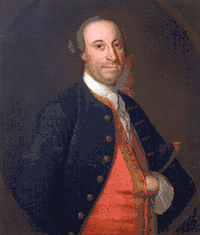John Carlyle (merchant)
John Carlyle (6 February 1720–October 1780) was a Scottish merchant who immigrated to British Colony of Virginia and became a leading landowner and social and political figure in Northern Virginia. He was a founding trustee and the first overseer of Alexandria, Virginia.

Biography
Born in Carlisle, Cumbria, England, Carlyle was the second surviving son of William Carlyle, an apothecary-surgeon, of a landed Scottish family from Dumfrieshire descended from the Lords Carlyle of Torthorwald and Rachel Murray of Murraythwaite, Dumfriesshire. He immigrated to Virginia in 1741 as a factor (agent) of English merchant William Hicks. He established himself as a merchant at Belhaven, a settlement that had grown up around a tobacco warehouse on the bluff overlooking the Potomac River that would become Alexandria, Virginia, in 1749.
Carlyle quickly met with financial success and, in 1747, married Sarah Fairfax, cousin of Thomas Fairfax, 6th Lord Fairfax of Cameron, from one of the most influential families in Virginia. From 1751–53, he built his house, now Carlyle House, in Alexandria and he also owned thousands of acres of land throughout Virginia, including three plantations. His business ventures included trading with England and the West Indies, retail operations in Alexandria, a foundry in the Shenandoah Valley, milling, and operation of a forge. He also undertook a number of civic and religious positions typical of a man of his status.
.png)

On 26 January 1754, he was appointed by Virginia's Lieutenant Governor Robert Dinwiddie, major and commissary of the Virginia forces in the French and Indian War. He was politically well-connected at the time and was friends with future President of the United States George Washington. In 1755, Carlyle's house was the initial headquarters for Major-General Edward Braddock in Virginia during the French and Indian War. The Congress of Alexandria convened at the house, most likely in the dining room, and here Braddock decided to make an expedition to Fort Duquesne which would result in his death. He was urged not to undertake the expedition by Washington who was then a volunteer aide-de-camp to Braddock.
Following the death of his wife Sarah on 22 January 1761, Carlyle married Sybil West, daughter of prominent Alexandrian Hugh West.
Around 1770, Caryle constructed a plantation house and summer residence in what is now Fairlington, Arlington, Virginia first called Torthorwald (after his family's ancestral home in Scotland) and later changed to Morven (a mythical land of the Gaels in an Ossian poem) which stood until 1942. He used this plantation as a stud farm and operated a grist mill on Four Mile Run above what is now Arlandria.
Carlyle died in 1780 and is buried at the Old Presbyterian Meeting House in Alexandria.
John Carlyle's only son to survive beyond childhood was George William Carlyle, born in 1766. He served in the cavalry (3rd Continental Light Dragoons under Lt. Col. William Washington, a cousin of George Washington) and was killed in South Carolina in the American Revolutionary War Battle of Eutaw Springs on 8 September 1781[1] at age 15, less than one year after the death of his father. John Carlyle's grandson through his daughter Sarah Carlyle, John Carlyle Herbert, inherited Carlyle House in 1781. Had George William Carlyle lived, he would have been entitled to the dormant barony as Lord Carlyle, after the death of his first cousin Joseph Dacre Carlyle who died without a son in 1804.
References
- "About John Carlyle" at Carlyle House Historic Park website
- Richard Henry Spencer. "The Carlyle Family." William and Mary College Quarterly Historical Magazine. Vol.18, No.3. (January 1910). pp. 201–212.
- Richard Henry Spencer. The Carlyle House and its Associations--Braddock's Headquarters--Here the Colonial Governors met in Council, April, 1755." William and Mary College Quarterly Historical Magazine. Vol.18, No.1. (July 1909). pp. 1–17.
- Documentary History of the American Revolution, Vol. 3 by Robert W. Gibbes, 1853.